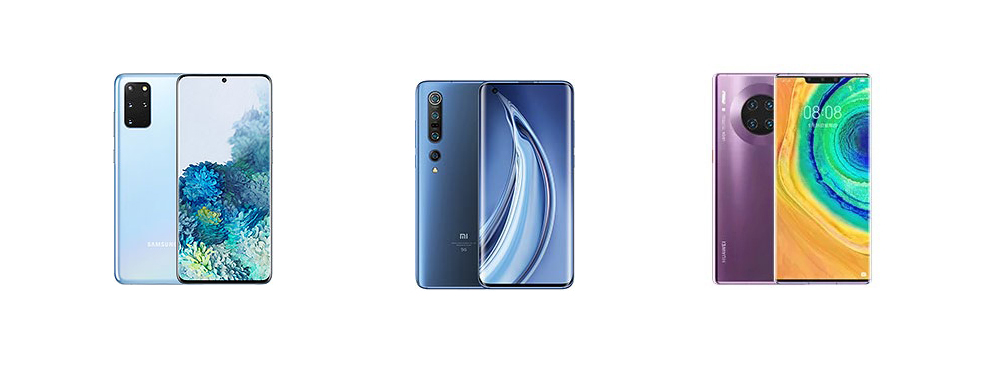We are in the middle of a generational change in the smartphone market. Samsung and Xiaomi just unveiled their new flagship series and they will soon go on sale. Just like every time a new flagship is official, we are here for a specs comparison. Here, we decided to compare Xiaomi Mi 10 Pro, Samsung Galaxy S20+ and Huawei Mate 30 Pro 5G: if we exclude the expensive and top-tier Galaxy S20 Ultra, they are the most powerful and expensive devices from the main three hi-tech giants in the Android smartphones world from the latest flagship lineups. Let’s highlight the differences between them and find out who is the best.
Xiaomi Mi 10 Pro vs Samsung Galaxy S20+ vs Huawei Mate 30 Pro 5G
| Huawei Mate 30 Pro | Samsung Galaxy S20+ | Xiaomi Mi 10 Pro | |
|---|---|---|---|
| DIMENSIONS AND WEIGHT | 158.1 x 73.1 x 8.8 mm, 198 g | 161.9 x 73.7 x 7.8 mm, 188 g | 162.6 x 74.8 x 9 mm, 208 g |
| DISPLAY | 6.53 inches, 1176 x 2400p (Full HD+), OLED | 6.7 inches, 1440 x 3200p (Quad HD+), Dynamic AMOLED 2X | 6.67 inches, 1080 x 2340p (Full HD+), Super AMOLED |
| PROCESSOR | Huawei Hisilicon Kirin 990, octa-core 2.86 GHz | Samsung Exynos 990, octa-core 2.73 GHz Qualcomm Snapdragon 865, octa-core 2.84 GHz |
Qualcomm Snapdragon 865, octa-core 2.84 GHz |
| MEMORY | 8 GB RAM, 128 GB – 8 GB RAM, 256 GB – 8 GB RAM, 512 GB – nano memory card slot | 12 GB RAM, 128 GB – 12 GB RAM, 256 GB – 12 GB RAM, 512 GB – micro SD slot | 8 GB RAM, 256 GB – 12 GB RAM, 256 GB – 12 GB RAM, 512 GB |
| SOFTWARE | Android 10, EMUI 10 | Android 10, One UI | Android 10, MIUI |
| CONNECTIVITY | Wi-Fi 802.11 a/b/g/n/ac, Bluetooth 5.0, GPS | Wi-Fi 802.11 a/b/g/n/ac/ax, Bluetooth 5.0, GPS | Wi-Fi 802.11 a/b/g/n/ac/ax, Bluetooth 5.0, GPS |
| CAMERA | Quad 40 + 40 + 8 MP + TOF camera, f/1.6 + f/1.8 + f/2.4 32 MP front camera |
Quad 12 + 64 + 12 + 0.3 MP TOF, f/1.8 + f/2.0 + f/2.2 + f/1.0 10 MP f/2.2 front camera |
Quad 108 + 8 + 12 + 20 MP, f/1.7 + f/2.0 + f/2.0 + f/2.2 20 MP f/2.0 front camera |
| BATTERY | 4500 mAh, fast charging 40W, Fast wireless charging 27W | 4500 mAh, fast charging 25W, Fast wireless charging 15W | 4500 mAh, fast charging 50W and fast wireless charging 30W |
| ADDITIONAL FEATURES | Hybrid Dual SIM slot, reverse wireless charging, waterproof IP68, Face ID | Hybrid Dual SIM slot, reverse wireless charging, waterproof IP68 | Dual SIM slot, reverse wireless charging |
Design
In each case, you get a simply awesome design. Xiaomi Mi 10 Pro and Samsung Galaxy S20+ sport a punch-hole display, while Huawei Mate 30 Pro 5G has a notched display but extremely curved bezels allowing to get rid of physical keys thanks to a side touch technology. Samsung Galaxy S20+ and Huawei Mate 30 Pro 5G are waterproof, while Xiaomi Mi 10 Pro is not. Huawei Mate 30 Pro 5G has a wide notch, but also a higher screen-to-body ratio. Further, you can find a 3D facial recognition system inside that notch. Samsung Galaxy S20+ is the only with an ultrasonic in-display fingerprint scanner (the others have an in-display fingerprint reader).
Display
We have no doubt about the fact that Galaxy S20+ boasts the best display. first of all, it is the only with a Quad HD+ resolution, so it provides a higher level of detail. Further, it comes with a higher 120 Hz refresh rate. And it even has a new generation Dynamic AMOLED 2X display with outstanding image quality, as well as the HDR10+ certification. Right after, we got the Xiaomi Mi 10 Pro with a 90 Hz display sporting a 180 Hz touch sampling rate, HDR10+, and high DCI-P3 coverage.
Hardware/Software
The best hardware is provided by the Xiaomi Mi 10 Pro and the U.S. variant of the Samsung Galaxy S20+ (not the European one). They both come with a Snapdragon 865 chipset including an integrated 5G modem, up to 12 GB of RAM and up to 512 GB of UFS 3.0 internal storage. Huawei Mate 30 Pro 5G has an inferior Kirin 990, but it is still an amazing flagship when it comes to performance. All run Android 10 out of the box, but they are customized by different user interfaces. With Xiaomi Mi 10 Pro and Galaxy S20+ boasting the same hardware department, software optimization will be decisive.
Camera
On the paper, Xiaomi Mi 10 Pro wins the camera comparison with a 108 MP quad camera department including a telephoto sensor with 10x hybrid optical zoom, a portrait lens, an ultrawide sensor and a 108 MP main sensor with a bright aperture and OIS. We are yet to test the Samsung Galaxy S20+, so we can not give you a definitive verdict yet. Our judgments are only based on the specs on the paper since both Xiaomi Mi 10 Pro and Galaxy S20+ just became official.
Battery
All of these devices feature a huge 4500 mAh battery, so we do expect a great battery life and no big differences between them. What really differs is the charging speed. Xiaomi Mi 10 Pro has both the fastest wired charging technology and the fastest wireless charging technology with 50W and 30W powers, respectively. Huawei Mate 30 Pro 5G comes right after with 50W and 27W, while Samsung Galaxy S20+ is way slower with 25W and 15W.
Price
Samsung Galaxy S20+ 5G starts from €1,099/$1199, Xiaomi Mi 10 Pro will cost about €660/$715 in China, and Huawei Mate 30 Pro is currently available for less than €1,000/$1100 globally thanks to online street prices. Overall, Xiaomi Mi 10 Pro and Samsung Galaxy S20+ look slightly superior to the Huawei Mate 30 Pro 5G due to their better hardware, display and more. Xiaomi Mi 10 Pro has better cameras than Samsung Galaxy S20+, while Galaxy S20+ has a better display and, unlike the Xiaomi Mi 10 Pro, it is waterproof. Further, Xiaomi Mi 10 Pro should launch globally at a more affordable price.
Xiaomi Mi 10 Pro vs Samsung Galaxy S20+ vs Huawei Mate 30 Pro 5G: PRO and CONS
Huawei Mate 30 Pro
PROS
- Innovative design
- Waterproof IP68
- 3D facial recognition
- Horizon display with side touch
CONS
- No Google services globally
Xiaomi Mi 10 Pro
PROS
- Awesome cameras
- Fastest wireless charging technology
- Fastest charging technology
- Good price
CONS
- Nothing particular
Samsung Galaxy S20+
PROS
- Best display
- Ultrasonic fingerprint reader
- IP68 waterproof
- Micro SD slot
CONS
- Slower charging







